Themed collection Luminogenic bioprobes for personal health technologies

Introduction to Luminogenic bioprobes for personal health technologies
Youhong Tang and Dan Ding introduce the Materials Chemistry Frontiers themed collection on luminogenic bioprobes for personal health technologies.

Mater. Chem. Front., 2021,5, 6292-6293
https://doi.org/10.1039/D1QM90061G
AIE polymers in sensing, imaging and theranostic applications
This review summarizes the progress of AIE polymers in sensing, imaging and theranostic applications in the recent 3 years, and the perspective and future development of AIE polymers are discussed briefly.
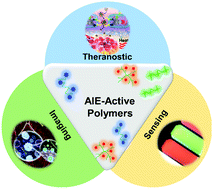
Mater. Chem. Front., 2021,5, 4073-4088
https://doi.org/10.1039/D1QM00078K
Hydrogel-derived luminescent scaffolds for biomedical applications
We provide a review on how luminescence functionality can be integrated with modifiable hydrogels to extend the frontiers of luminescent materials for health technologies.
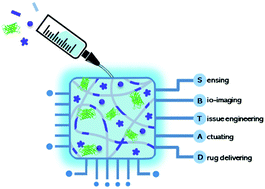
Mater. Chem. Front., 2021,5, 3524-3548
https://doi.org/10.1039/D0QM01140A
Materials with aggregation-induced emission characteristics for applications in diagnosis, theragnosis, disease mechanism study and personalized medicine
In this review, we introduce the recent progress on the employment of AIE-active materials for healthcare-related applications, such as clinical diagnosis, theragnosis, disease mechanism studies and personalized medicines.
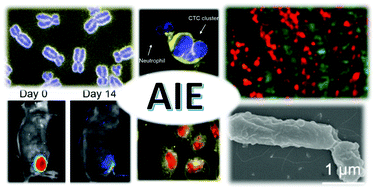
Mater. Chem. Front., 2021,5, 3322-3343
https://doi.org/10.1039/D0QM01132K
Organometallic AIEgens for biological theranostics
The marriage of AIEgens and organometallic complexes has shown great potential in biological probes and photosensitizers.
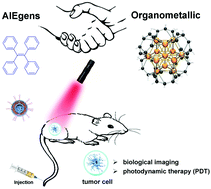
Mater. Chem. Front., 2021,5, 3281-3297
https://doi.org/10.1039/D0QM01130D
Detection of kidney disease biomarkers based on fluorescence technology
This review summarizes the recent progress in the development of fluorescent probes and methods for the detection of biomarkers for the diagnosis of kidney diseases.
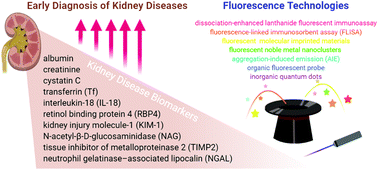
Mater. Chem. Front., 2021,5, 2124-2142
https://doi.org/10.1039/D0QM01009J
Nanoprobes with aggregation-induced emission for theranostics
This review summarizes the latest advancement of nanoprobes with aggregation-induced emission (AIE) for image-guided therapy.

Mater. Chem. Front., 2021,5, 603-626
https://doi.org/10.1039/D0QM00617C
Detection of biomarkers in body fluids using bioprobes based on aggregation-induced emission fluorogens
This review describes the constituents and clinical biomarkers in urine, saliva, and sweat, and the role of currently developed AIE bioprobes that can quantitatively detect disease-related biomarkers in these biofluids.
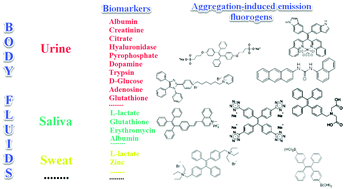
Mater. Chem. Front., 2020,4, 2548-2570
https://doi.org/10.1039/D0QM00376J
Hydrogen peroxide-responsive AIE probe for imaging-guided organelle targeting and photodynamic cancer cell ablation
A versatile red/near-infrared AIE probe, TTPy-H2O2, was developed for the specific visualization of H2O2 with mitochondria targeting ability, meanwhile achieving efficient photodynamic therapy for cancer cells.
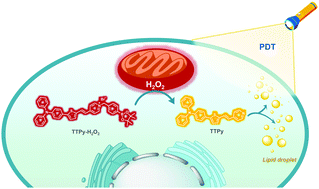
Mater. Chem. Front., 2021,5, 3489-3496
https://doi.org/10.1039/D1QM00328C
Photodynamic antitumor activity of aggregation-induced emission luminogens as chemosensitizers for paclitaxel by concurrent induction of apoptosis and autophagic cell death
TPE-Py inhibits the growth of tumor cells by inducing apoptotic and autophagic cell death, and the effect could be enhanced by white light irradiation. TPE-Py enhances the anticancer activity of Ptx by inducing apoptosis by white light irradiation.
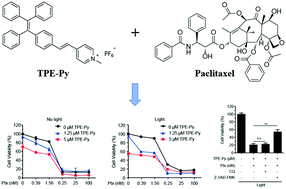
Mater. Chem. Front., 2021,5, 3448-3457
https://doi.org/10.1039/D1QM00089F
A dentin hypersensitivity treatment using highly stable photothermal conversion nanoparticles
A type of photothermal biocompatible organic nanoparticles with a high PCE (40.6%) was developed and investigated, followed by the achievement of a significantly more effective phototheranostic dental hypersensitivity treatment combined with laser.
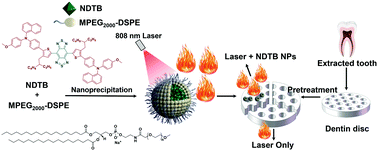
Mater. Chem. Front., 2021,5, 3388-3395
https://doi.org/10.1039/D0QM01006E
Rapid membrane-specific AIEgen featuring with wash-free imaging and sensitive light-excited killing of cells, bacteria, and fungi
C6-BD equipped with AIE and ESIPT characteristics was used to visualize the cell membrane with high selectivity, stability, and wash-free operation. It also universal for imaging of bacteria and fungi with light-excited killing via ROS generation.

Mater. Chem. Front., 2021,5, 2724-2729
https://doi.org/10.1039/D0QM01046D
Novel strategy to prepare fluorescent polymeric nanoparticles based on aggregation-induced emission via precipitation polymerization for fluorescent lateral flow assay
A novel strategy to prepare fluorescent polymeric nanoparticles based on aggregation-induced emission via precipitation polymerization for fluorescent lateral flow assay.
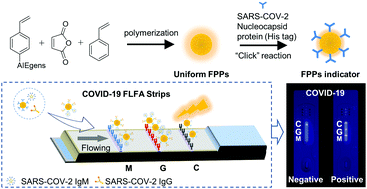
Mater. Chem. Front., 2021,5, 2452-2458
https://doi.org/10.1039/D0QM00998A
Sensitive and specific detection of peroxynitrite and in vivo imaging of inflammation by a “simple” AIE bioprobe
A facile synthesized AIE bioprobe was developed to detect peroxynitrite sensitively and specifically. This bioprobe can realize both in vitro ONOO− detection and in vivo visualization of inflammation.
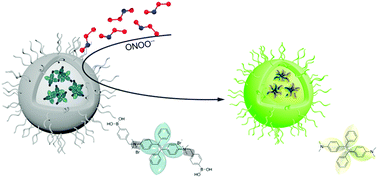
Mater. Chem. Front., 2021,5, 1830-1835
https://doi.org/10.1039/D0QM01004A
An easily available ratiometric AIE probe for nitroxyl visualization in vitro and in vivo
An easily available ratiometric fluorescent probe (TCFPB-HNO) with aggregation-induced emission (AIE) characteristics was developed for the first time for the detection and visualization of nitroxyl (HNO) in vitro and in vivo.
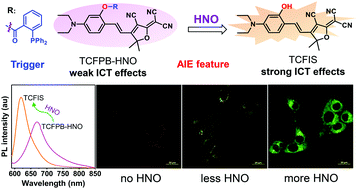
Mater. Chem. Front., 2021,5, 1817-1823
https://doi.org/10.1039/D0QM00995D
Photo-triggered Zn2+ release for the regulation of zinc enzymes
A photo-triggered Zn2+ release system was developed based on HBTH–Zn–TAT NPs, which showed an excellent light-dependent “on–off” performance for Zn2+ release and the precise regulation of extra- and intracellular zinc enzyme activities.
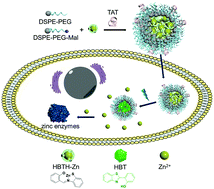
Mater. Chem. Front., 2021,5, 1824-1829
https://doi.org/10.1039/D0QM00947D
Understanding the lipid production mechanism in Euglena gracilis with a fast-response AIEgen bioprobe, DPAS
The aggregation-induced emission (AIE) bioprobe, DPAS can rapidly and easily detect lipid drops in Euglena gracilis as highly valued metabolites under nitrogen and calcium deprivation and glucose supplementation in darkness.
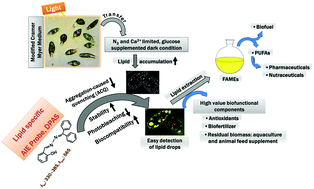
Mater. Chem. Front., 2021,5, 268-283
https://doi.org/10.1039/D0QM00621A
About this collection
Welcome to Materials Chemistry Frontiers themed collection on luminogenic bioprobes for personal health technologies.
Personal health technologies offer to empower healthy choices, manage personal care, identify health conditions early in their course and optimise visits to health professionals However, these widespread technologies are still limited by the narrow scope of health indicators they detect. They are yet to leverage our proven understanding of pathology and integrate sophisticated biosensors that measure health markers from bodily fluids such as blood, saliva, urine and sweat. They are yet to truly realise the benefits from consumers taking daily measures of vital, well-evidenced health indicators that inform their personal health and can be analysed to give insights into population health.
The newly established Australia-China Joint Centre for Personal Health Technologies leading by Flinders University and Nankai University and partnering with La Trobe University, South China University of Technology, Shandong Academy of Sciences, Motherson Innovations and AIEgen Biotech tries to break down disciplinary boundaries, leverage unique capabilities from China and Australia, and foster collaborative research to advance developments in an exciting new technology area, aggregation-induced emission luminogens (AIEgens), and apply it to personal health. Organized by this Joint Research Centre, this web theme showcases the most recent and important research findings in luminogenic bioprobes for personal health technologies, especially emerging AIEgen based bioprobes.
Guest Editors: Youhong Tang (Flinders University), Dan Ding (Nankai University)
More articles will be added as soon as they are published.